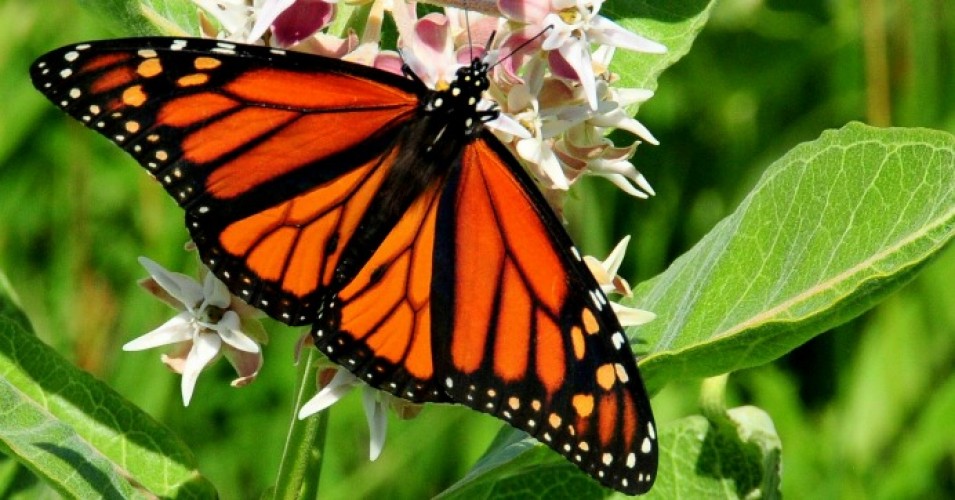Celebrate Pollinator Week – help monitor the monarch butterfly!
Researcher Maxim Larrivée urges North American residents to join monarch conservation efforts
Montreal, 23 June 2016—The Commission for Environmental Cooperation (CEC) is celebrating Pollinator Week by publishing a conversation with Maxim Larrivée, Section Head, Entomological Collections and Research, at the Montréal Insectarium, about the importance of monarch butterfly conservation in North America.
Pollinator Week is being celebrated June 20 through 26, with events planned across Canada, Mexico and the United States.
Since 2007, the CEC has supported monarch butterfly conservation work by the three countries, which are home to the monarch's unique and endangered migratory phenomenon. The CEC has two monarch projects underway as part of its current cooperative work program.
Larrivée recently visited the CEC to talk about Mission Monarch and how we can all be part of continental monitoring and conservation efforts for the iconic butterfly.

Monarch butterfly expert Maxim Larrivée
Why is it important to protect North America's monarch butterfly migration?
There are biological and cultural reasons for this. From a biological standpoint, the monarch butterfly is a keystone species, not only in the habitats where it breeds but also in those through which it migrates. Improving the condition of these habitats will have several positive impacts on other pollinators and coexisting species in these habitats.
The other element is that monarchs have a major cultural significance in every country they fly through, whether it is Canada, Mexico or the United States. Everyone has their own "monarch story." The monarch may have been your introduction to nature when you were a kid. If you are a parent, you may have been amazed to see your child encounter a monarch butterfly or caterpillar.
How can North American citizens help in the monitoring of the monarch butterfly?
Dive feet first into fields where milkweed grows! Monarchs breed over such a large territory that no single research team can assess where monarchs are breeding and how they are migrating. We need the efforts of all citizens out there to help us document where monarchs are breeding by counting eggs and larvae.
What is Mission Monarch and how can citizens get involved in this new Canadian research initiative?
Mission Monarch is a citizen science platform that is anchored in monarch research by Canadian scientists to evaluate where monarchs breed and where they are more successful in breeding.
The platform concept is very simple: we ask people to count milkweed plants around their houses or cottages and then provide that information by logging into the Mission Monarch website. People are also encouraged to count the eggs and the caterpillars that they find on milkweed plants.
How can a North American approach to citizen-led science initiatives benefit monarch butterfly conservation and help other pollinators as well?
A North American approach to monarch butterfly conservation is essential. Monarchs overwinter in Mexico, breed in Canada and the United States, and migrate through the three countries. It would be misleading to think that conservation efforts in only one or two of the three countries they use in their life cycle can be effective.
The information that project participants will provide through Mission Monarch and other North American citizen-led science initiatives will make an enormous difference in our understanding of the drivers of monarch migration and reproduction and will help us improve conditions for all pollinators and animals that live in the habitats where monarchs breed and through which they migrate.

A monarch nectaring on showy milkweed. (Photo: Tom Koerner/USFWS)
About the CEC
The Commission for Environmental Cooperation (CEC) was established in 1994 by the governments of Canada, Mexico and the United States through the North American Agreement on Environmental Cooperation, a parallel environmental agreement to NAFTA. As of 2020, the CEC is recognized and maintained by the Environmental Cooperation Agreement, in parallel with the new Free Trade Agreement of North America. The CEC brings together a wide range of stakeholders, including the general public, Indigenous people, youth, nongovernmental organizations, academia, and the business sector, to seek solutions to protect North America’s shared environment while supporting sustainable development for the benefit of present and future generations
The CEC is governed and funded equally by the Government of Canada through Environment and Climate Change Canada, the Government of the United States of Mexico through the Secretaría de Medio Ambiente y Recursos Naturales, and the Government of the United States of America through the Environmental Protection Agency.